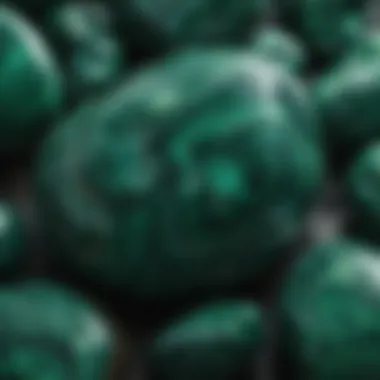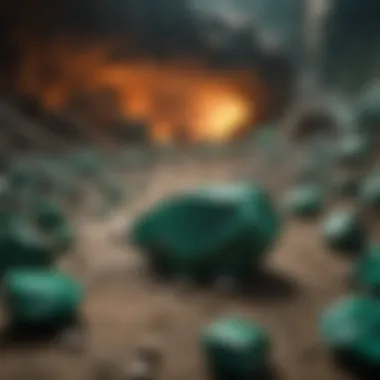Exploring Malachite Prices: Factors and Trends


Intro
Understanding the price of malachite requires an analysis that goes beyond its aesthetic appeal. Malachite has long been valued not only for its unique, rich green hues but also for its historical significance. Collectors, enthusiasts, and investors often seek to know what influences the price of this captivating gemstone. This article provides a detailed examination of various factors that affect the pricing of malachite, including market trends, quality indicators, and ethical considerations surrounding its mining.
History and Origins
Overview of Collectibles, Rocks, and Fossils
The allure of malachite can be linked to its historical significance as a gemstone that has captivated humanity for centuries. It is often found in collectible and decorative items, as well as in jewelry. Due to its vibrant colors and opaque nature, it has been a prized material throughout various eras, notably in ancient Egypt where it was used in ornaments and amulets. Malachite is not just a rock; it embodies a blend of geological and historical narratives that hold great value in the eyes of collectors.
Historical Significance and Cultural Impact
Malachite's historical importance stretches back to ancient civilizations. In ancient Egypt, malachite was associated with the goddess Hathor and was thought to provide protection. Considered a stone of transformation, it was also utilized in burial artifacts. Beyond Egypt, malachite found importance in various cultures, from the Roman Empire to African tribes, symbolizing fertility and wealth. Today, its cultural resonance and the stories attached to it can significantly influence its market value. Collectors appreciate these narratives and their connection to the piece, often willing to pay a premium for historically significant specimens.
Identification and Classification
Guide to Identifying Rocks and Fossils
Malachite is identifiable through certain physical characteristics. Collectors should look for:
- Color: A striking green, often banded with lighter and darker shades.
- Texture: Typically smooth or waxy to the touch.
- Luster: Exhibits a vitreous to silky shine.
- Hardness: On the Mohs scale, malachite measures between 3.5 to 4.
These features help distinguish malachite from similar stones, ensuring collectors are fully aware of the authenticity of their pieces.
Common Types and Variations
Malachite can exhibit various forms and patterns, which play a crucial role in determining its value. Some common variations include:
- Banded Malachite: Characterized by distinct layers of varying shades of green.
- Polished Malachite: Often used in jewelry and decor, known for its glossy finish.
- Rough Malachite: Raw pieces that show natural formations and textures, appealing to some collectors.
Collecting malachite becomes a rich adventure when one understands these different types and their market implications. Not only does this knowledge deepen appreciation, but it also informs better investment decisions.
"Understanding the nuances of malachite can transform a casual interest into a comprehensive collection strategy."
This exploration sets the stage for a deeper dive into the many layers that influence the pricing of this exceptional mineral.
Preface to Malachite
Malachite holds a distinct place in the realm of gemstones. Understanding malachite is crucial, especially for collectors and enthusiasts who value not just its physical beauty but also its multifaceted nature influenced by various economic and historical factors. The journey of malachite pricing is intricate, and a comprehensive analysis reveals an array of considerations that can affect its value.
What is Malachite?
Malachite is a green copper carbonate mineral often recognized for its striking banded appearance. It is primarily composed of copper carbonate hydroxide, and its vibrant green color often varies from light green to an almost black hue. Found in many parts of the world, notable deposits are found in the Democratic Republic of Congo, Russia, and Australia. Once, it served as a popular pigment for artists and craftsmen and now has transformed into a prized gemstone used in jewelry as well as ornamental objects. Understanding what malachite is essential for recognizing its value in both historical and contemporary markets.
Characteristics of Malachite
Malachite's distinctive features contribute greatly to its allure and pricing structure.
- Color Intensity: The depth of green can significantly influence value. Darker and more intense hues are often more sought after.
- Clarity and Polishing: A higher degree of clarity, without visible flaws, enhances the gem's appeal. Well-polished surfaces amplify its reflective qualities, thus increasing desirability.
- Origin: The location from which malachite is sourced also plays a key role in determining its value. For instance, malachite from the Democratic Republic of Congo is particularly noted for its quality.


The unique combination of these characteristics will form the basis of discussions surrounding malachite pricing. Each trait can affect how collectors perceive value, impacting both current trends and future projections.
Historical Significance of Malachite
Malachite has held a significant position throughout history, not just as a gemstone, but also as a symbol of wealth and cultural identity. Understanding its historical significance helps to contextualize its current value and demand. This section will explore cultural importance and historical value fluctuations, demonstrating how past events and societal values shape today's market for this unique mineral.
Cultural Importance
From ancient times, malachite was revered for its vivid green coloration and distinctive banding, which made it appealing to various cultures. The Egyptians used malachite in jewelry and talismans, believing it possessed protective qualities. It was often associated with the goddess Hathor, representing joy and love. In addition, the stone was ground into powder and used as eye shadow. This not only highlights its aesthetic appeal but also its role in cultural practices.
In contrast, in the broader scope of the Mediterranean, malachite appeared in mosaics and decorative arts. The Romans utilized malachite for ornamental purposes, indicative of wealth and status. This cultural significance continued through the ages, where artisans saw malachite not just as a commodity but as a canvas for artistic expression.
Historical Value Fluctuations
The value of malachite has experienced shifts throughout history. The discovery of large deposits in the 19th century led to an increase in availability, slightly lowering the price. However, as mining practices evolved, the focus on preserving natural resources returned interest to malachite, causing a surge in demand. The rise of the global jewelry market in the 20th century also contributed to this phenomenon.
Historically, malachite was often more than a simple gemstone. Its intrinsic connection to trade routes, particularly in Africa and Europe, established it as a desirable good among collectors and enthusiasts. In modern times, fluctuations in price correlate with global events, such as economic downturns or shifts in ethical mining practices.
"Malachite has not only adorned the elite but carried rich meanings across different cultures, making its historical value multifaceted."
Understanding the cultural and historical context aids collectors in recognizing how these factors influence their collection's worth. This deeper knowledge equips them with the necessary insight to make informed decisions in today’s market, aligning individual interests with broader industry trends.
Current Market Trends
Understanding the current market trends surrounding malachite is essential for collectors and investors alike. Keeping abreast of how these trends evolve can inform purchasing decisions and enhance the overall strategy for investment in this unique mineral. As with most natural resources, the demand and price of malachite can fluctuate based on various influences, making it imperative to recognize both current states and emerging patterns.
Market Demand for Malachite
The demand for malachite has seen a significant rise in recent years, partly driven by its captivating aesthetic properties and historical allure. Antique applications of malachite in jewelry and decorative items create a cultural cachet that appeals to collectors. More recently, the use of malachite in modern jewelry design has expanded its appeal among younger generations.
Furthermore, the unique green hues of malachite can complement a wide range of styles, making it a favored choice for interior decoration and art installations. This has led to increased interest not only from individual collectors but also from designers and retailers seeking to incorporate this striking gemstone into their offerings. In addition, social media platforms have allowed for greater visibility of this mineral, spurring on demand from a new cohort of enthusiasts.
Price Variations by Region
Price variations in malachite are notably influenced by regional factors. Certain geographical sources may yield higher-quality stones, causing a discrepancy in pricing across different markets. For example, malachite sourced from the Democratic Republic of the Congo is often considered superior in terms of color and clarity, commanding higher prices in global markets.
- Africa: The African market, particularly from gem-rich regions, typically showcases a range of prices largely influenced by quality and availability.
- Asia: In contrast, Asian markets may present lower price points influenced by local supply and demand dynamics, although the quality may not fully match that from Africa.
- Europe and North America: Prices in these regions may vary based on import costs, with additional markup from local vendors. Collectors should note that prices can be particularly high at auctions and galleries, where rarity and condition significantly affect pricing.
By keeping a close eye on these market conditions, collectors can position themselves to make informed purchasing decisions that reflect both current trends and potential future shifts in the malachite market.
Factors Influencing Malachite Pricing
Understanding the dynamics of malachite pricing is complex yet essential for collectors and enthusiasts. It requires an examination of various elements that contribute to the valuation of this remarkable gemstone. Among these, quality indicators, supply chain dynamics, and ethical aspects form the backbone of the pricing structure. Each of these factors can greatly affect market trends and, consequently, the price buyers are willing to pay. This section dissects these key influences to provide a clearer picture of what determines malachite's market value.
Quality Indicators
Quality indicators are significant contributors to malachite's overall market price. They encapsulate aspects like color intensity, clarity, and origin, each playing a critical role in the gemstone’s desirability and value.
Color Intensity
Color intensity is perhaps the most defining quality of malachite. The stronger and richer the green hue, the more valuable the stone typically is. Bright and vivid shades are often preferred by collectors. A unique feature of high-quality malachite is its deep, uniform color, which signifies fewer impurities. However, there are some disadvantages. Some lighter or duller pieces may be less sought after, and therefore often available at a lower price.


Clarity and Polishing
Clarity and polishing are vital to the aesthetic appeal of malachite. A high level of clarity ensures that the details of the stone are visible, while skillful polishing enhances its shine and smoothness. Stones with fewer visible inclusions are usually considered more desirable, as they present a cleaner appearance. However, excessive polishing may result in the loss of natural textures, which can deter some collectors. Therefore, balance is important.
Origin
The origin of the malachite can impact its pricing significantly. Malachite sourced from specific regions, particularly those renowned for producing high-quality stones, can demand a premium. For example, malachite from the Democratic Republic of Congo is often esteemed due to its color quality and clarity. However, lesser-known sources may offer lower prices but also lower quality. Hence, knowing the origin can guide collectors in making informed purchasing decisions.
Supply Chain Dynamics
Supply chain dynamics are the second pillar influencing malachite pricing. From mining to market distribution, each stage contributes to the final price point of the gemstone. Understanding these dynamics can reveal underlying trends in the malachite market.
Mining Practices
Mining practices play a crucial role in determining the price of malachite. Sustainable and ethical mining operations tend to drive up costs due to the implementation of better labor practices and environmental safety measures. Conversely, practices that are harmful to the environment or local communities may result in cheaper stones but can lead to negative perceptions and lower demand. Collectors increasingly prefer ethically sourced stones, which can affect their willingness to pay more.
Transportation Costs
The cost of transportation also bears heavily on malachite prices. This expense varies depending on the complexity of logistics and the distance from the source to the market. For instance, malachite mined in remote areas may incur significant shipping costs, thereby increasing its market price. Efficient transportation companies can help reduce these costs, making malachite more accessible to collectors, but any disruptions can lead to price fluctuations.
Market Availability
Market availability is essential to how malachite prices are set. If demand outstrips supply, prices will naturally rise, whereas an oversupply can lead to lower prices. Seasonal variations in mining and changes in collector interest can influence the market. Keeping an eye on overall availability is key for anyone looking to invest in malachite as it can lead to strategic purchasing decisions, ultimately affecting long-term value.
"Pricing for malachite is not just about quality but also about understanding the broader market forces at play."
Thus, both quality indicators and supply chain dynamics merge to form a complex pricing landscape for malachite. These factors need careful consideration for collectors and investors alike.
Ethical Considerations in Malachite Mining
The significance of ethical considerations in malachite mining cannot be overstated. As collectors and enthusiasts delve deeper into the world of gemstones, the demand for ethically sourced malachite increases. This conscious shift not only impacts the market but also fosters a more sustainable industry. Understanding environmental harm and fair trade practices is essential for informed purchases.
Environmental Impact
The environmental impact of mining activities is a critical concern. Malachite mining techniques can disturb local ecosystems, leading to deforestation, soil erosion, and water contamination. To mitigate these effects, environmentally responsible practices must be adopted. Sustainable mining initiatives involve using advanced techniques that minimize damage. For example, partnerships with local communities can lead to rehabilitation projects that restore mined areas, promoting biodiversity and ecosystem recovery. By prioritizing eco-friendly practices, the industry can preserve essential habitats while providing this beautiful gemstone.
Fair Trade Practices
Fair trade practices are another crucial aspect of ethical considerations in malachite sourcing. Ensuring that miners receive fair compensation for their work fosters community development and better living standards. Certification programs assess the practices of mining operations, ensuring that they follow ethical labor guidelines. This includes providing safe working conditions, fair wages, and respect for workers' rights. By supporting fair trade, collectors can contribute to a more equitable market where profits benefit the entire community rather than just a select few.
“Ethical mining is not just a trend, but a necessity for the longevity of the gemstone market.”
Embracing these principles not only enhances the value of malachite as a collectible but also aligns with the values of conscientious consumers. As the market evolves, being well-informed about these ethical layers can enrich the collecting experience.
Collecting and Valuation of Malachite
Collecting malachite holds both aesthetic and financial value for enthusiasts and investors. The appeal lies not just in its vibrant green hues and unique patterns, but also in the history and the cultural narratives underpinning it. Collectors must navigate a landscape of authenticity, quality, and market fluctuations when valuing this striking mineral. Understanding these elements is crucial for making informed acquisitions that complement both personal collections and financial portfolios.
Assessing Value for Collectors
The value of malachite can be assessed through various parameters. Some of these include:


- Quality of the Specimen: The richness of color and the clarity are vital indicators. Deep green specimens with minimal imperfections tend to fetch higher prices.
- Size and Form: Larger, well-formed pieces are generally more sought after. Tumbling, cabochons, or carved pieces can also significantly alter their market value.
- Origin: Malachite sourced from well-known locales, like the Democratic Republic of Congo, may command higher prices due to their recognized quality.
- Artistic Value: Malachite is often used in jewelry and decorative arts, and pieces that exhibit skilled craftsmanship are valued more highly.
Buyers must be wary of synthetic malachite, as they may be misrepresented. For collectors, using reputable dealers or certified gemologists helps ensure the authenticity of the specimens. Additionally, keeping abreast of market trends helps in understanding potential shifts in value.
Storage and Care Tips
Proper storage and care of malachite can prolong its beauty and value. Here are some essential tips:
- Avoid UV Exposure: Long-term exposure to sunlight can fade malachite’s color. Store pieces in a dark or shaded area.
- Humidity Control: Maintain a stable environment. High humidity can promote deterioration, so it is crucial to keep storage areas dry.
- Gentle Cleaning: Use a soft, damp cloth to clean the surface, avoiding harsh chemicals that can damage the stone.
- Individual Wrapping: When storing, wrap each piece in a soft cloth or use padded boxes to prevent scratches.
By observing these care guidelines, collectors can maintain both the aesthetic and financial value of their malachite specimens. Ultimately, being informed about the valuation process and employing proper care practices contributes significantly to a successful collecting experience.
Future Predictions for Malachite Pricing
Understanding the future predictions for malachite pricing is crucial for collectors and investors alike. As the market for gemstones can be volatile, anticipating price changes aids stakeholders in making informed decisions. Knowing the factors expected to influence malachite’s value ensures that both new and seasoned collectors can navigate the complexities of the market. This part of the analysis focuses on emerging trends and potential investment opportunities that may shape the future landscape of malachite pricing.
Emerging Trends
A few significant trends are likely to impact the malachite market in the coming years.
- Sustainability Movement: As consumers become more environmentally conscious, there is a growing demand for ethically sourced gemstones. This trend heightens the value of malachite that is obtained through responsible mining practices. People appreciate stones with a clear provenance, which may lead to a price increase.
- Market Digitalization: Online platforms are increasingly becoming popular for buying and selling gemstones. Websites such as Facebook and Reddit facilitate community discussions and transactions. This market digitalization can enhance visibility, leading to higher demand and potentially pushing prices upward.
- Art and Design Influence: In the realm of decoration and fashion, malachite has gained attention for its distinctive coloration and intricate banding. Designers are integrating this gemstone into various products, including jewelry and home decor. The elevated status in design aesthetics can drive its price as demand rises.
"The intersection of design, ethics, and technology will mold the future of malachite pricing."
These emerging trends indicate that the market is dynamic. Collectors may need to adjust their strategies accordingly to understand how each trend interacts with market forces.
Potential Investment Opportunities
Adapting to trends may also present promising investment opportunities for those interested in malachite. Several factors can offer a foundation for potential gains:
- Limited Availability: As mining practices evolve, the availability of high-quality malachite may diminish. This scarcity can lead to increased prices, making it a wise choice for investors.
- Cultural and Artistic Value: Given malachite's historical significance and its usage in fine art, its intrinsic value may grow over time. As heritage and craftsmanship become more appreciated, pieces of significant artistic merit can appreciate dramatically.
- Market Education: Growing knowledge among collectors about malachite’s unique qualities can spark increased interest and investment. As more individuals recognize its worth, the demand could result in price appreciation.
Investors should keep a close eye on these opportunities. With careful planning and an informed understanding of market dynamics, serious collectors can position themselves favorably in the malachite market.
Culmination: The Value Proposition of Malachite
Understanding the value proposition of malachite is critical for collectors and those interested in the gemstone market. This conclusion encapsulates the core elements discussed throughout the article, integrating insights on historical significance with current market trends. The analysis of factors influencing price, alongside ethical considerations, offers a clearer view of how malachite is positioned today.
The uniqueness of malachite, characterized by its vibrant green hues and striking patterns, contributes to its desirability. Additionally, its historical context adds layers to its current market perception. The gemstone has been admired for centuries, often associated with various cultures, which enhances its intrinsic value.
In essence, the value of malachite is not merely monetary but is enriched by its cultural legacy, aesthetic appeal, and the expertise required for quality assessment. Therefore, potential collectors should consider these elements critically when evaluating malachite. They should understand the balance between beauty and market forces that shape pricing.
Summarizing Key Insights
In reviewing the various aspects of malachite pricing, several key insights arise:
- Quality Matters: The quality indicators like color intensity, clarity, and origin play a significant role in the valuation of malachite.
- Market Dynamics: Prices vary based on regional demand and availability. The understanding of these dynamics is essential for making informed purchasing decisions.
- Ethical Sourcing: With growing awareness of environmental impact and fair trade practices, ethical considerations have become a prominent factor in gemstone valuation.
- Future Potential: Emerging trends signal potential investment opportunities, especially as collectors seek unique pieces that stand out in their collections.
Overall, these insights provide a foundation for collectors and investors seeking to navigate the complexities of the malachite market.
Final Thoughts on Collecting Malachite
Collecting malachite can be a rewarding endeavor, but it requires diligence and understanding of the market. For serious collectors, knowledge about the stone’s quality, provenance, and ethical implications could impact overall satisfaction and investment value.
Engagement in the malachite market is not just about acquiring a beautiful stone. It is about recognizing its cultural significance, understanding price trends, and being aware of the implications of mining practices.
Thus, collectors should prioritize careful research and verification of authenticity before making acquisitions. Educating oneself on quality indicators and market dynamics leads to better decision-making and a more fulfilling collecting experience. The excitement of adding a rare piece of malachite to a collection is deeply linked to this sense of informed participation in the gemstone world.



